Analysis of Factors and Determinants in Australian Trade
VerifiedAdded on 2020/03/28
|12
|3770
|49
Report
AI Summary
This report provides a comprehensive analysis of the determinants and factors influencing Australian international trade. It begins with an introduction to the importance of trade for the Australian economy, emphasizing specialization, importation, and exportation. The report explores the reasons for economies engaging in trade, focusing on specialization and comparative advantage. It delves into the specifics of Australian imports and exports, identifying key commodities and trading partners like China. Furthermore, the report examines the determinants of the exchange rate, including inflation, interest rates, current account deficits, public debt, and terms of trade, illustrating their impact on trade dynamics. The report uses figures to represent Australian trade balance and terms of trade over time. The report concludes with a brief discussion of political stability and economic performance as factors influencing trade.
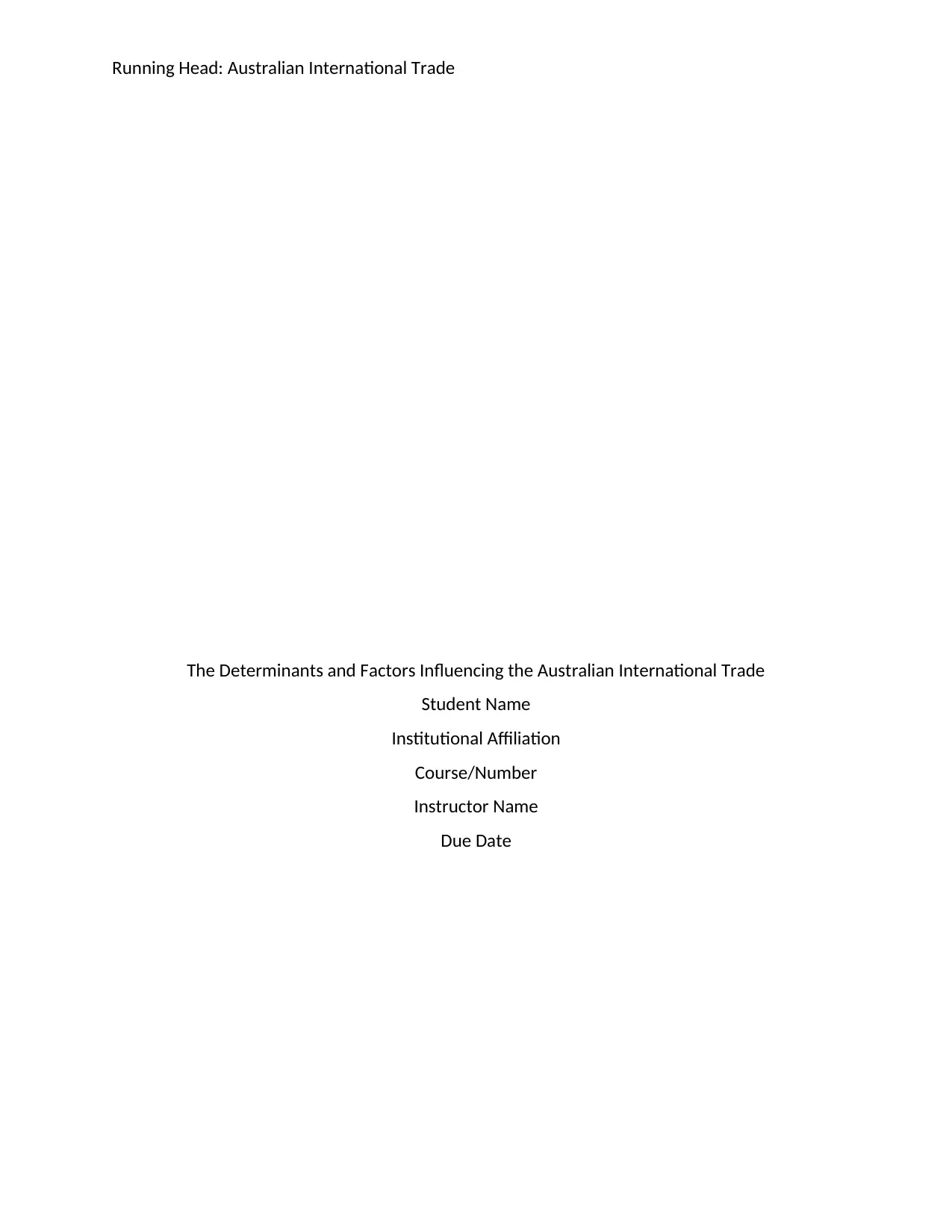
Running Head: Australian International Trade
The Determinants and Factors Influencing the Australian International Trade
Student Name
Institutional Affiliation
Course/Number
Instructor Name
Due Date
The Determinants and Factors Influencing the Australian International Trade
Student Name
Institutional Affiliation
Course/Number
Instructor Name
Due Date
Paraphrase This Document
Need a fresh take? Get an instant paraphrase of this document with our AI Paraphraser
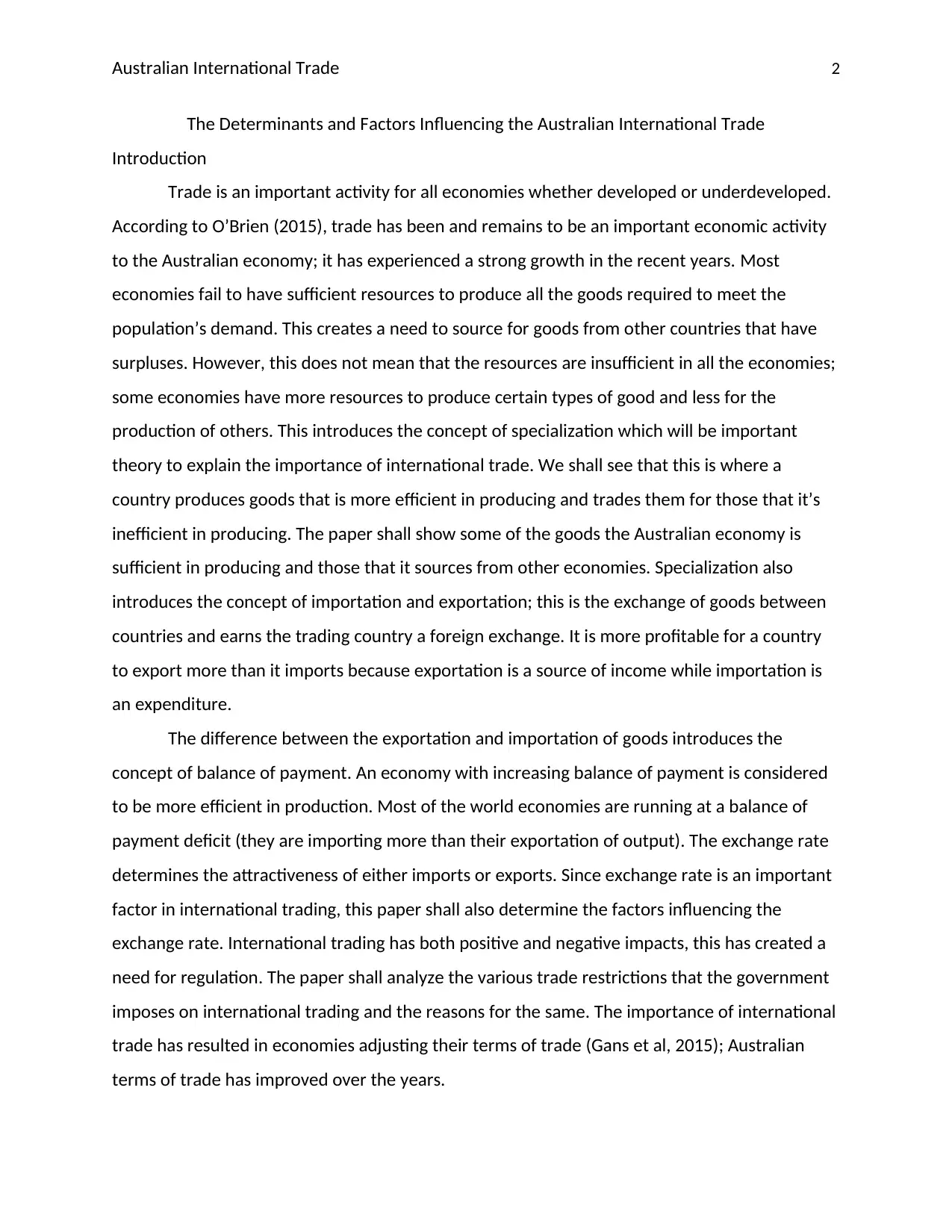
Australian International Trade 2
The Determinants and Factors Influencing the Australian International Trade
Introduction
Trade is an important activity for all economies whether developed or underdeveloped.
According to O’Brien (2015), trade has been and remains to be an important economic activity
to the Australian economy; it has experienced a strong growth in the recent years. Most
economies fail to have sufficient resources to produce all the goods required to meet the
population’s demand. This creates a need to source for goods from other countries that have
surpluses. However, this does not mean that the resources are insufficient in all the economies;
some economies have more resources to produce certain types of good and less for the
production of others. This introduces the concept of specialization which will be important
theory to explain the importance of international trade. We shall see that this is where a
country produces goods that is more efficient in producing and trades them for those that it’s
inefficient in producing. The paper shall show some of the goods the Australian economy is
sufficient in producing and those that it sources from other economies. Specialization also
introduces the concept of importation and exportation; this is the exchange of goods between
countries and earns the trading country a foreign exchange. It is more profitable for a country
to export more than it imports because exportation is a source of income while importation is
an expenditure.
The difference between the exportation and importation of goods introduces the
concept of balance of payment. An economy with increasing balance of payment is considered
to be more efficient in production. Most of the world economies are running at a balance of
payment deficit (they are importing more than their exportation of output). The exchange rate
determines the attractiveness of either imports or exports. Since exchange rate is an important
factor in international trading, this paper shall also determine the factors influencing the
exchange rate. International trading has both positive and negative impacts, this has created a
need for regulation. The paper shall analyze the various trade restrictions that the government
imposes on international trading and the reasons for the same. The importance of international
trade has resulted in economies adjusting their terms of trade (Gans et al, 2015); Australian
terms of trade has improved over the years.
The Determinants and Factors Influencing the Australian International Trade
Introduction
Trade is an important activity for all economies whether developed or underdeveloped.
According to O’Brien (2015), trade has been and remains to be an important economic activity
to the Australian economy; it has experienced a strong growth in the recent years. Most
economies fail to have sufficient resources to produce all the goods required to meet the
population’s demand. This creates a need to source for goods from other countries that have
surpluses. However, this does not mean that the resources are insufficient in all the economies;
some economies have more resources to produce certain types of good and less for the
production of others. This introduces the concept of specialization which will be important
theory to explain the importance of international trade. We shall see that this is where a
country produces goods that is more efficient in producing and trades them for those that it’s
inefficient in producing. The paper shall show some of the goods the Australian economy is
sufficient in producing and those that it sources from other economies. Specialization also
introduces the concept of importation and exportation; this is the exchange of goods between
countries and earns the trading country a foreign exchange. It is more profitable for a country
to export more than it imports because exportation is a source of income while importation is
an expenditure.
The difference between the exportation and importation of goods introduces the
concept of balance of payment. An economy with increasing balance of payment is considered
to be more efficient in production. Most of the world economies are running at a balance of
payment deficit (they are importing more than their exportation of output). The exchange rate
determines the attractiveness of either imports or exports. Since exchange rate is an important
factor in international trading, this paper shall also determine the factors influencing the
exchange rate. International trading has both positive and negative impacts, this has created a
need for regulation. The paper shall analyze the various trade restrictions that the government
imposes on international trading and the reasons for the same. The importance of international
trade has resulted in economies adjusting their terms of trade (Gans et al, 2015); Australian
terms of trade has improved over the years.
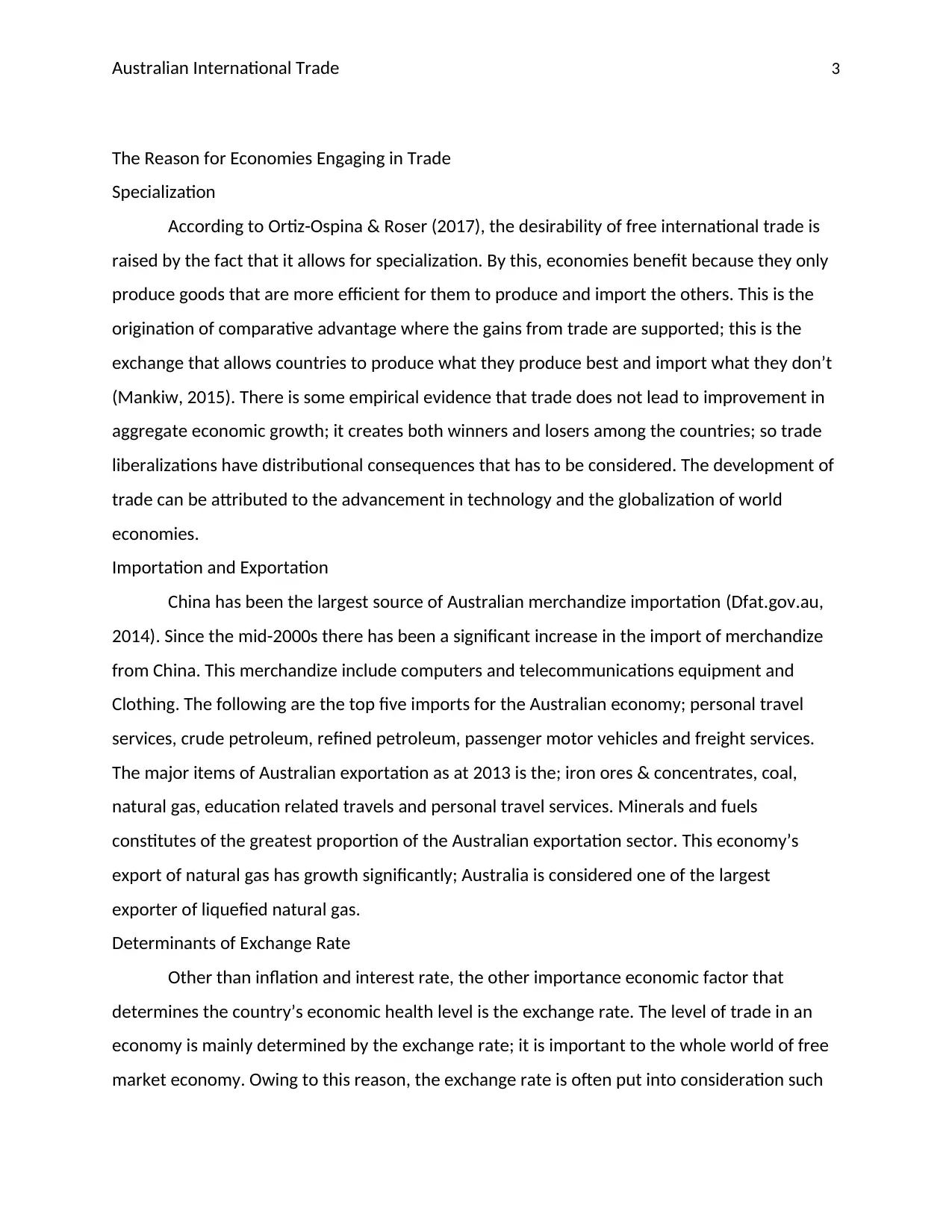
Australian International Trade 3
The Reason for Economies Engaging in Trade
Specialization
According to Ortiz-Ospina & Roser (2017), the desirability of free international trade is
raised by the fact that it allows for specialization. By this, economies benefit because they only
produce goods that are more efficient for them to produce and import the others. This is the
origination of comparative advantage where the gains from trade are supported; this is the
exchange that allows countries to produce what they produce best and import what they don’t
(Mankiw, 2015). There is some empirical evidence that trade does not lead to improvement in
aggregate economic growth; it creates both winners and losers among the countries; so trade
liberalizations have distributional consequences that has to be considered. The development of
trade can be attributed to the advancement in technology and the globalization of world
economies.
Importation and Exportation
China has been the largest source of Australian merchandize importation (Dfat.gov.au,
2014). Since the mid-2000s there has been a significant increase in the import of merchandize
from China. This merchandize include computers and telecommunications equipment and
Clothing. The following are the top five imports for the Australian economy; personal travel
services, crude petroleum, refined petroleum, passenger motor vehicles and freight services.
The major items of Australian exportation as at 2013 is the; iron ores & concentrates, coal,
natural gas, education related travels and personal travel services. Minerals and fuels
constitutes of the greatest proportion of the Australian exportation sector. This economy’s
export of natural gas has growth significantly; Australia is considered one of the largest
exporter of liquefied natural gas.
Determinants of Exchange Rate
Other than inflation and interest rate, the other importance economic factor that
determines the country’s economic health level is the exchange rate. The level of trade in an
economy is mainly determined by the exchange rate; it is important to the whole world of free
market economy. Owing to this reason, the exchange rate is often put into consideration such
The Reason for Economies Engaging in Trade
Specialization
According to Ortiz-Ospina & Roser (2017), the desirability of free international trade is
raised by the fact that it allows for specialization. By this, economies benefit because they only
produce goods that are more efficient for them to produce and import the others. This is the
origination of comparative advantage where the gains from trade are supported; this is the
exchange that allows countries to produce what they produce best and import what they don’t
(Mankiw, 2015). There is some empirical evidence that trade does not lead to improvement in
aggregate economic growth; it creates both winners and losers among the countries; so trade
liberalizations have distributional consequences that has to be considered. The development of
trade can be attributed to the advancement in technology and the globalization of world
economies.
Importation and Exportation
China has been the largest source of Australian merchandize importation (Dfat.gov.au,
2014). Since the mid-2000s there has been a significant increase in the import of merchandize
from China. This merchandize include computers and telecommunications equipment and
Clothing. The following are the top five imports for the Australian economy; personal travel
services, crude petroleum, refined petroleum, passenger motor vehicles and freight services.
The major items of Australian exportation as at 2013 is the; iron ores & concentrates, coal,
natural gas, education related travels and personal travel services. Minerals and fuels
constitutes of the greatest proportion of the Australian exportation sector. This economy’s
export of natural gas has growth significantly; Australia is considered one of the largest
exporter of liquefied natural gas.
Determinants of Exchange Rate
Other than inflation and interest rate, the other importance economic factor that
determines the country’s economic health level is the exchange rate. The level of trade in an
economy is mainly determined by the exchange rate; it is important to the whole world of free
market economy. Owing to this reason, the exchange rate is often put into consideration such
⊘ This is a preview!⊘
Do you want full access?
Subscribe today to unlock all pages.

Trusted by 1+ million students worldwide
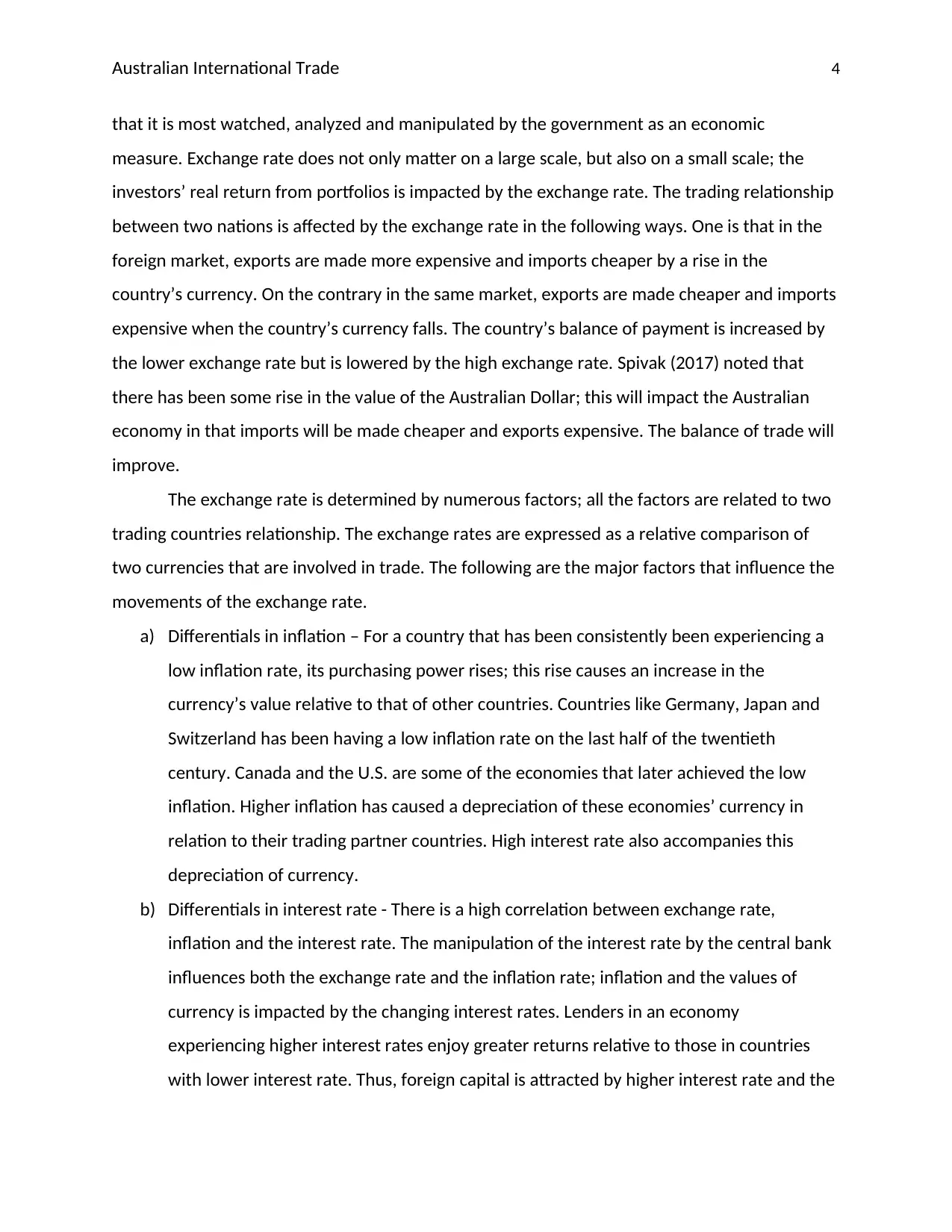
Australian International Trade 4
that it is most watched, analyzed and manipulated by the government as an economic
measure. Exchange rate does not only matter on a large scale, but also on a small scale; the
investors’ real return from portfolios is impacted by the exchange rate. The trading relationship
between two nations is affected by the exchange rate in the following ways. One is that in the
foreign market, exports are made more expensive and imports cheaper by a rise in the
country’s currency. On the contrary in the same market, exports are made cheaper and imports
expensive when the country’s currency falls. The country’s balance of payment is increased by
the lower exchange rate but is lowered by the high exchange rate. Spivak (2017) noted that
there has been some rise in the value of the Australian Dollar; this will impact the Australian
economy in that imports will be made cheaper and exports expensive. The balance of trade will
improve.
The exchange rate is determined by numerous factors; all the factors are related to two
trading countries relationship. The exchange rates are expressed as a relative comparison of
two currencies that are involved in trade. The following are the major factors that influence the
movements of the exchange rate.
a) Differentials in inflation – For a country that has been consistently been experiencing a
low inflation rate, its purchasing power rises; this rise causes an increase in the
currency’s value relative to that of other countries. Countries like Germany, Japan and
Switzerland has been having a low inflation rate on the last half of the twentieth
century. Canada and the U.S. are some of the economies that later achieved the low
inflation. Higher inflation has caused a depreciation of these economies’ currency in
relation to their trading partner countries. High interest rate also accompanies this
depreciation of currency.
b) Differentials in interest rate - There is a high correlation between exchange rate,
inflation and the interest rate. The manipulation of the interest rate by the central bank
influences both the exchange rate and the inflation rate; inflation and the values of
currency is impacted by the changing interest rates. Lenders in an economy
experiencing higher interest rates enjoy greater returns relative to those in countries
with lower interest rate. Thus, foreign capital is attracted by higher interest rate and the
that it is most watched, analyzed and manipulated by the government as an economic
measure. Exchange rate does not only matter on a large scale, but also on a small scale; the
investors’ real return from portfolios is impacted by the exchange rate. The trading relationship
between two nations is affected by the exchange rate in the following ways. One is that in the
foreign market, exports are made more expensive and imports cheaper by a rise in the
country’s currency. On the contrary in the same market, exports are made cheaper and imports
expensive when the country’s currency falls. The country’s balance of payment is increased by
the lower exchange rate but is lowered by the high exchange rate. Spivak (2017) noted that
there has been some rise in the value of the Australian Dollar; this will impact the Australian
economy in that imports will be made cheaper and exports expensive. The balance of trade will
improve.
The exchange rate is determined by numerous factors; all the factors are related to two
trading countries relationship. The exchange rates are expressed as a relative comparison of
two currencies that are involved in trade. The following are the major factors that influence the
movements of the exchange rate.
a) Differentials in inflation – For a country that has been consistently been experiencing a
low inflation rate, its purchasing power rises; this rise causes an increase in the
currency’s value relative to that of other countries. Countries like Germany, Japan and
Switzerland has been having a low inflation rate on the last half of the twentieth
century. Canada and the U.S. are some of the economies that later achieved the low
inflation. Higher inflation has caused a depreciation of these economies’ currency in
relation to their trading partner countries. High interest rate also accompanies this
depreciation of currency.
b) Differentials in interest rate - There is a high correlation between exchange rate,
inflation and the interest rate. The manipulation of the interest rate by the central bank
influences both the exchange rate and the inflation rate; inflation and the values of
currency is impacted by the changing interest rates. Lenders in an economy
experiencing higher interest rates enjoy greater returns relative to those in countries
with lower interest rate. Thus, foreign capital is attracted by higher interest rate and the
Paraphrase This Document
Need a fresh take? Get an instant paraphrase of this document with our AI Paraphraser
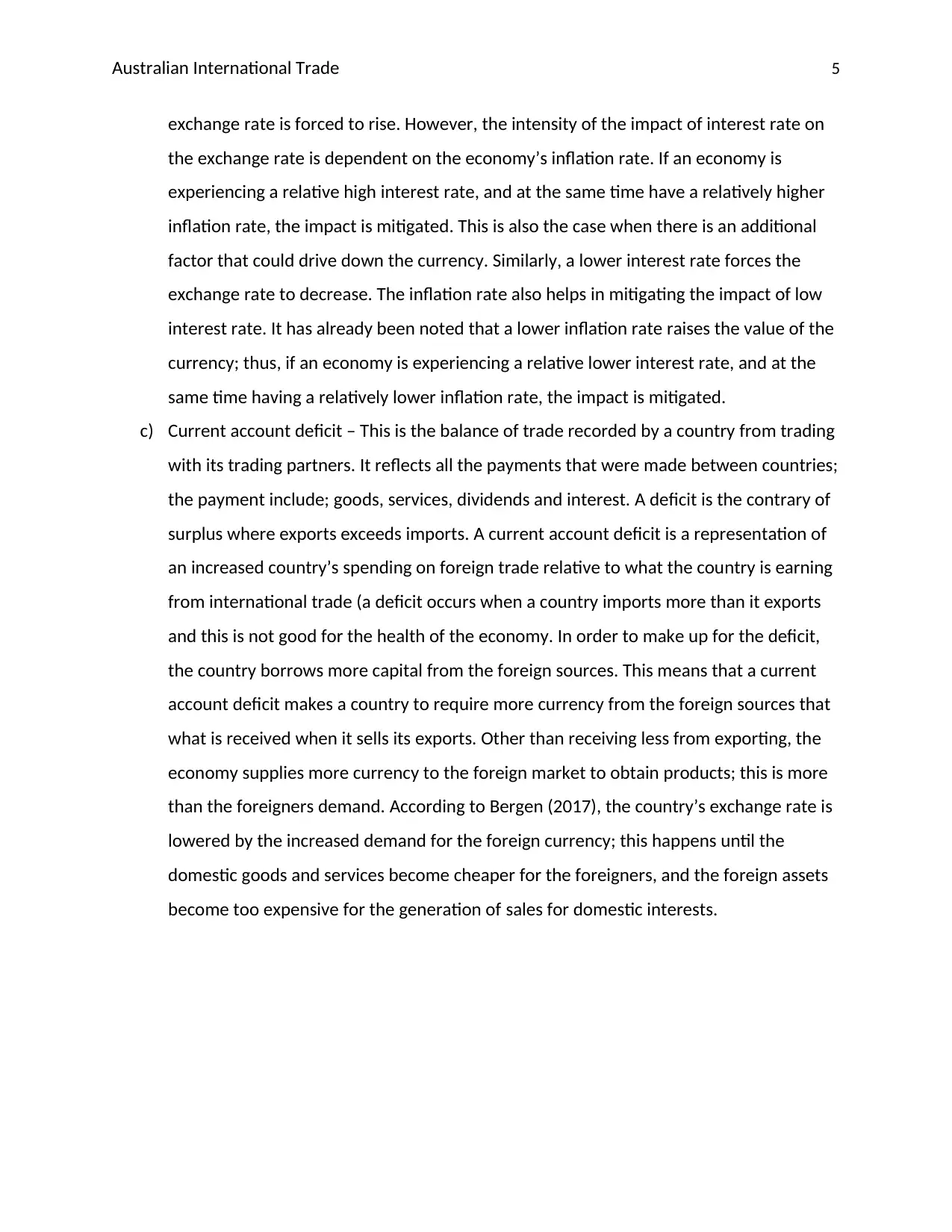
Australian International Trade 5
exchange rate is forced to rise. However, the intensity of the impact of interest rate on
the exchange rate is dependent on the economy’s inflation rate. If an economy is
experiencing a relative high interest rate, and at the same time have a relatively higher
inflation rate, the impact is mitigated. This is also the case when there is an additional
factor that could drive down the currency. Similarly, a lower interest rate forces the
exchange rate to decrease. The inflation rate also helps in mitigating the impact of low
interest rate. It has already been noted that a lower inflation rate raises the value of the
currency; thus, if an economy is experiencing a relative lower interest rate, and at the
same time having a relatively lower inflation rate, the impact is mitigated.
c) Current account deficit – This is the balance of trade recorded by a country from trading
with its trading partners. It reflects all the payments that were made between countries;
the payment include; goods, services, dividends and interest. A deficit is the contrary of
surplus where exports exceeds imports. A current account deficit is a representation of
an increased country’s spending on foreign trade relative to what the country is earning
from international trade (a deficit occurs when a country imports more than it exports
and this is not good for the health of the economy. In order to make up for the deficit,
the country borrows more capital from the foreign sources. This means that a current
account deficit makes a country to require more currency from the foreign sources that
what is received when it sells its exports. Other than receiving less from exporting, the
economy supplies more currency to the foreign market to obtain products; this is more
than the foreigners demand. According to Bergen (2017), the country’s exchange rate is
lowered by the increased demand for the foreign currency; this happens until the
domestic goods and services become cheaper for the foreigners, and the foreign assets
become too expensive for the generation of sales for domestic interests.
exchange rate is forced to rise. However, the intensity of the impact of interest rate on
the exchange rate is dependent on the economy’s inflation rate. If an economy is
experiencing a relative high interest rate, and at the same time have a relatively higher
inflation rate, the impact is mitigated. This is also the case when there is an additional
factor that could drive down the currency. Similarly, a lower interest rate forces the
exchange rate to decrease. The inflation rate also helps in mitigating the impact of low
interest rate. It has already been noted that a lower inflation rate raises the value of the
currency; thus, if an economy is experiencing a relative lower interest rate, and at the
same time having a relatively lower inflation rate, the impact is mitigated.
c) Current account deficit – This is the balance of trade recorded by a country from trading
with its trading partners. It reflects all the payments that were made between countries;
the payment include; goods, services, dividends and interest. A deficit is the contrary of
surplus where exports exceeds imports. A current account deficit is a representation of
an increased country’s spending on foreign trade relative to what the country is earning
from international trade (a deficit occurs when a country imports more than it exports
and this is not good for the health of the economy. In order to make up for the deficit,
the country borrows more capital from the foreign sources. This means that a current
account deficit makes a country to require more currency from the foreign sources that
what is received when it sells its exports. Other than receiving less from exporting, the
economy supplies more currency to the foreign market to obtain products; this is more
than the foreigners demand. According to Bergen (2017), the country’s exchange rate is
lowered by the increased demand for the foreign currency; this happens until the
domestic goods and services become cheaper for the foreigners, and the foreign assets
become too expensive for the generation of sales for domestic interests.
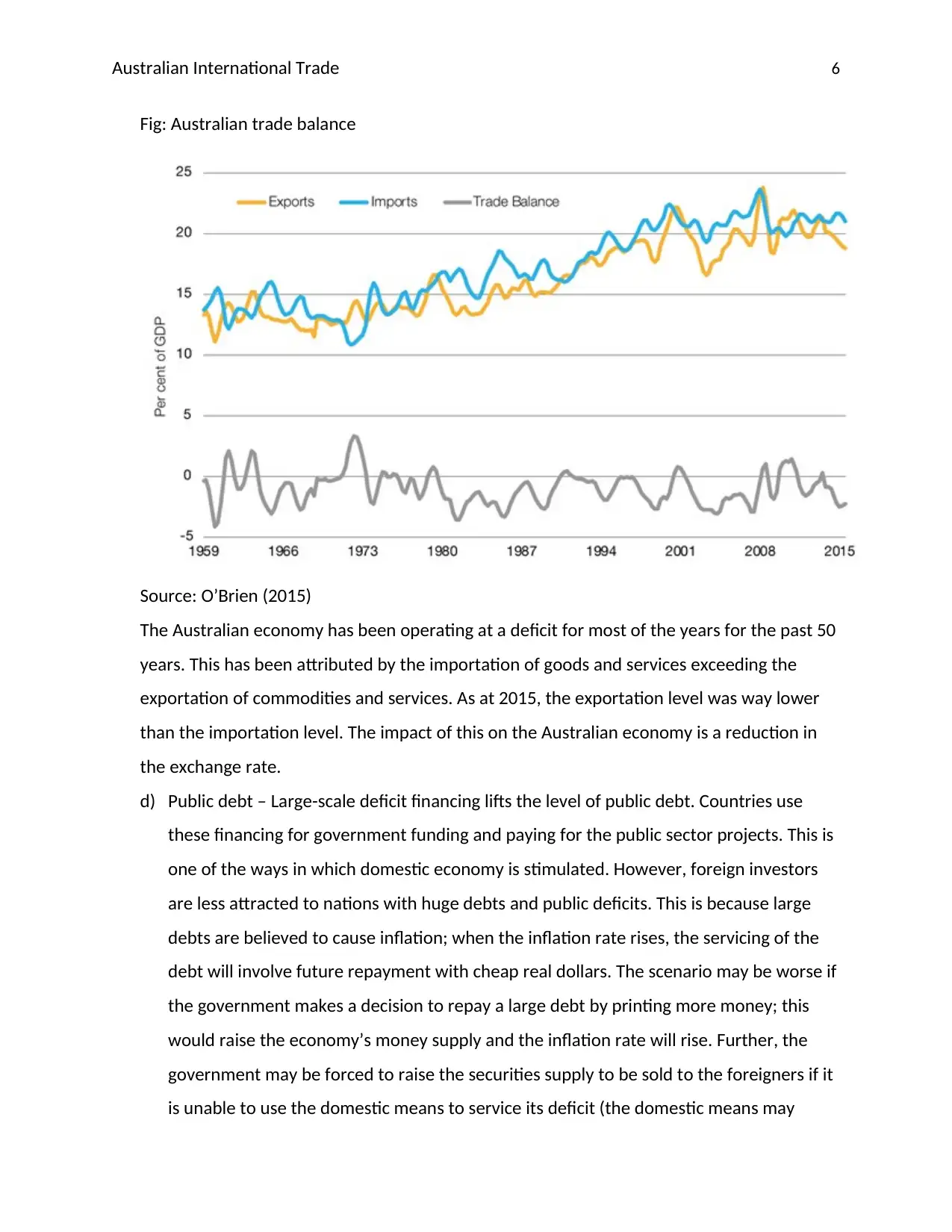
Australian International Trade 6
Fig: Australian trade balance
Source: O’Brien (2015)
The Australian economy has been operating at a deficit for most of the years for the past 50
years. This has been attributed by the importation of goods and services exceeding the
exportation of commodities and services. As at 2015, the exportation level was way lower
than the importation level. The impact of this on the Australian economy is a reduction in
the exchange rate.
d) Public debt – Large-scale deficit financing lifts the level of public debt. Countries use
these financing for government funding and paying for the public sector projects. This is
one of the ways in which domestic economy is stimulated. However, foreign investors
are less attracted to nations with huge debts and public deficits. This is because large
debts are believed to cause inflation; when the inflation rate rises, the servicing of the
debt will involve future repayment with cheap real dollars. The scenario may be worse if
the government makes a decision to repay a large debt by printing more money; this
would raise the economy’s money supply and the inflation rate will rise. Further, the
government may be forced to raise the securities supply to be sold to the foreigners if it
is unable to use the domestic means to service its deficit (the domestic means may
Fig: Australian trade balance
Source: O’Brien (2015)
The Australian economy has been operating at a deficit for most of the years for the past 50
years. This has been attributed by the importation of goods and services exceeding the
exportation of commodities and services. As at 2015, the exportation level was way lower
than the importation level. The impact of this on the Australian economy is a reduction in
the exchange rate.
d) Public debt – Large-scale deficit financing lifts the level of public debt. Countries use
these financing for government funding and paying for the public sector projects. This is
one of the ways in which domestic economy is stimulated. However, foreign investors
are less attracted to nations with huge debts and public deficits. This is because large
debts are believed to cause inflation; when the inflation rate rises, the servicing of the
debt will involve future repayment with cheap real dollars. The scenario may be worse if
the government makes a decision to repay a large debt by printing more money; this
would raise the economy’s money supply and the inflation rate will rise. Further, the
government may be forced to raise the securities supply to be sold to the foreigners if it
is unable to use the domestic means to service its deficit (the domestic means may
⊘ This is a preview!⊘
Do you want full access?
Subscribe today to unlock all pages.

Trusted by 1+ million students worldwide
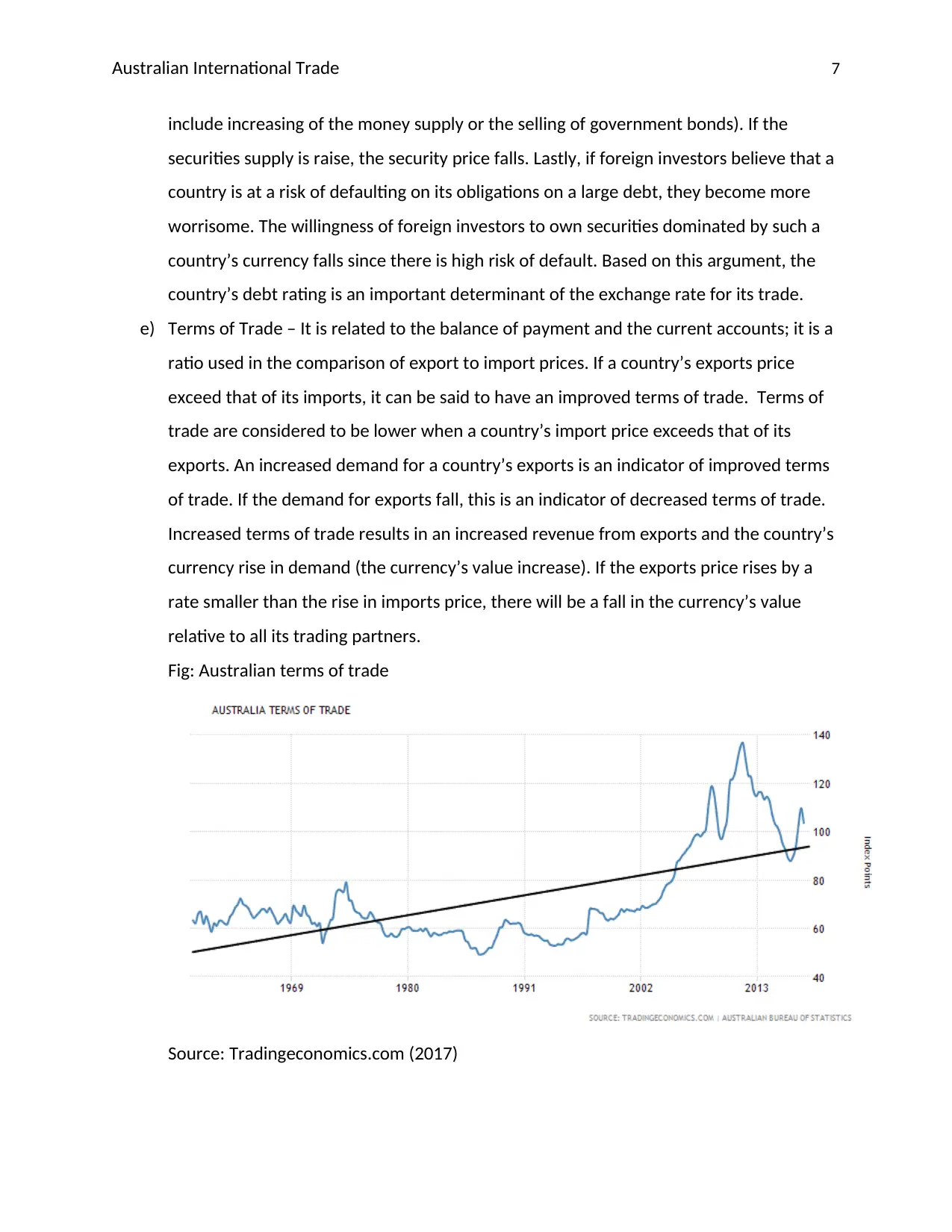
Australian International Trade 7
include increasing of the money supply or the selling of government bonds). If the
securities supply is raise, the security price falls. Lastly, if foreign investors believe that a
country is at a risk of defaulting on its obligations on a large debt, they become more
worrisome. The willingness of foreign investors to own securities dominated by such a
country’s currency falls since there is high risk of default. Based on this argument, the
country’s debt rating is an important determinant of the exchange rate for its trade.
e) Terms of Trade – It is related to the balance of payment and the current accounts; it is a
ratio used in the comparison of export to import prices. If a country’s exports price
exceed that of its imports, it can be said to have an improved terms of trade. Terms of
trade are considered to be lower when a country’s import price exceeds that of its
exports. An increased demand for a country’s exports is an indicator of improved terms
of trade. If the demand for exports fall, this is an indicator of decreased terms of trade.
Increased terms of trade results in an increased revenue from exports and the country’s
currency rise in demand (the currency’s value increase). If the exports price rises by a
rate smaller than the rise in imports price, there will be a fall in the currency’s value
relative to all its trading partners.
Fig: Australian terms of trade
Source: Tradingeconomics.com (2017)
include increasing of the money supply or the selling of government bonds). If the
securities supply is raise, the security price falls. Lastly, if foreign investors believe that a
country is at a risk of defaulting on its obligations on a large debt, they become more
worrisome. The willingness of foreign investors to own securities dominated by such a
country’s currency falls since there is high risk of default. Based on this argument, the
country’s debt rating is an important determinant of the exchange rate for its trade.
e) Terms of Trade – It is related to the balance of payment and the current accounts; it is a
ratio used in the comparison of export to import prices. If a country’s exports price
exceed that of its imports, it can be said to have an improved terms of trade. Terms of
trade are considered to be lower when a country’s import price exceeds that of its
exports. An increased demand for a country’s exports is an indicator of improved terms
of trade. If the demand for exports fall, this is an indicator of decreased terms of trade.
Increased terms of trade results in an increased revenue from exports and the country’s
currency rise in demand (the currency’s value increase). If the exports price rises by a
rate smaller than the rise in imports price, there will be a fall in the currency’s value
relative to all its trading partners.
Fig: Australian terms of trade
Source: Tradingeconomics.com (2017)
Paraphrase This Document
Need a fresh take? Get an instant paraphrase of this document with our AI Paraphraser
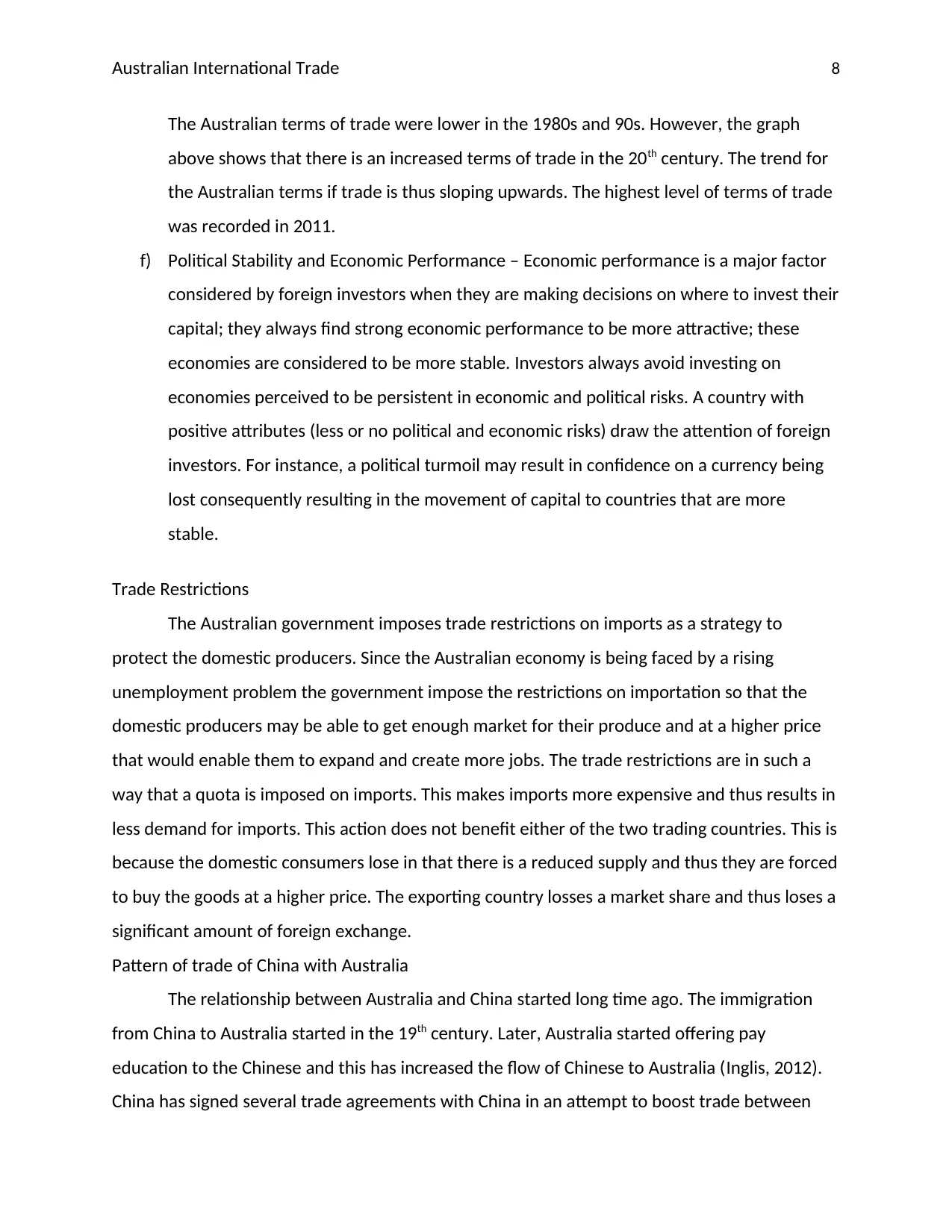
Australian International Trade 8
The Australian terms of trade were lower in the 1980s and 90s. However, the graph
above shows that there is an increased terms of trade in the 20th century. The trend for
the Australian terms if trade is thus sloping upwards. The highest level of terms of trade
was recorded in 2011.
f) Political Stability and Economic Performance – Economic performance is a major factor
considered by foreign investors when they are making decisions on where to invest their
capital; they always find strong economic performance to be more attractive; these
economies are considered to be more stable. Investors always avoid investing on
economies perceived to be persistent in economic and political risks. A country with
positive attributes (less or no political and economic risks) draw the attention of foreign
investors. For instance, a political turmoil may result in confidence on a currency being
lost consequently resulting in the movement of capital to countries that are more
stable.
Trade Restrictions
The Australian government imposes trade restrictions on imports as a strategy to
protect the domestic producers. Since the Australian economy is being faced by a rising
unemployment problem the government impose the restrictions on importation so that the
domestic producers may be able to get enough market for their produce and at a higher price
that would enable them to expand and create more jobs. The trade restrictions are in such a
way that a quota is imposed on imports. This makes imports more expensive and thus results in
less demand for imports. This action does not benefit either of the two trading countries. This is
because the domestic consumers lose in that there is a reduced supply and thus they are forced
to buy the goods at a higher price. The exporting country losses a market share and thus loses a
significant amount of foreign exchange.
Pattern of trade of China with Australia
The relationship between Australia and China started long time ago. The immigration
from China to Australia started in the 19th century. Later, Australia started offering pay
education to the Chinese and this has increased the flow of Chinese to Australia (Inglis, 2012).
China has signed several trade agreements with China in an attempt to boost trade between
The Australian terms of trade were lower in the 1980s and 90s. However, the graph
above shows that there is an increased terms of trade in the 20th century. The trend for
the Australian terms if trade is thus sloping upwards. The highest level of terms of trade
was recorded in 2011.
f) Political Stability and Economic Performance – Economic performance is a major factor
considered by foreign investors when they are making decisions on where to invest their
capital; they always find strong economic performance to be more attractive; these
economies are considered to be more stable. Investors always avoid investing on
economies perceived to be persistent in economic and political risks. A country with
positive attributes (less or no political and economic risks) draw the attention of foreign
investors. For instance, a political turmoil may result in confidence on a currency being
lost consequently resulting in the movement of capital to countries that are more
stable.
Trade Restrictions
The Australian government imposes trade restrictions on imports as a strategy to
protect the domestic producers. Since the Australian economy is being faced by a rising
unemployment problem the government impose the restrictions on importation so that the
domestic producers may be able to get enough market for their produce and at a higher price
that would enable them to expand and create more jobs. The trade restrictions are in such a
way that a quota is imposed on imports. This makes imports more expensive and thus results in
less demand for imports. This action does not benefit either of the two trading countries. This is
because the domestic consumers lose in that there is a reduced supply and thus they are forced
to buy the goods at a higher price. The exporting country losses a market share and thus loses a
significant amount of foreign exchange.
Pattern of trade of China with Australia
The relationship between Australia and China started long time ago. The immigration
from China to Australia started in the 19th century. Later, Australia started offering pay
education to the Chinese and this has increased the flow of Chinese to Australia (Inglis, 2012).
China has signed several trade agreements with China in an attempt to boost trade between
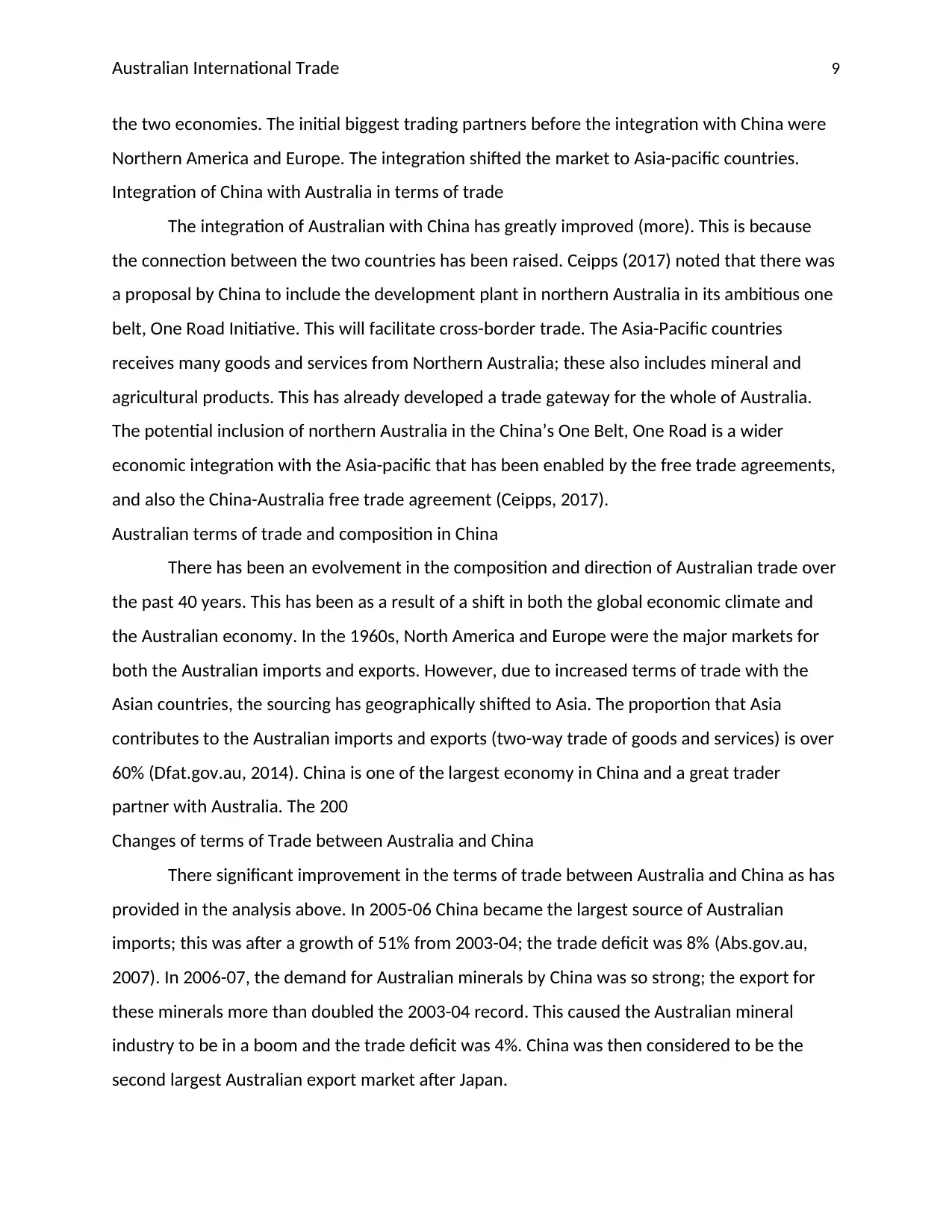
Australian International Trade 9
the two economies. The initial biggest trading partners before the integration with China were
Northern America and Europe. The integration shifted the market to Asia-pacific countries.
Integration of China with Australia in terms of trade
The integration of Australian with China has greatly improved (more). This is because
the connection between the two countries has been raised. Ceipps (2017) noted that there was
a proposal by China to include the development plant in northern Australia in its ambitious one
belt, One Road Initiative. This will facilitate cross-border trade. The Asia-Pacific countries
receives many goods and services from Northern Australia; these also includes mineral and
agricultural products. This has already developed a trade gateway for the whole of Australia.
The potential inclusion of northern Australia in the China’s One Belt, One Road is a wider
economic integration with the Asia-pacific that has been enabled by the free trade agreements,
and also the China-Australia free trade agreement (Ceipps, 2017).
Australian terms of trade and composition in China
There has been an evolvement in the composition and direction of Australian trade over
the past 40 years. This has been as a result of a shift in both the global economic climate and
the Australian economy. In the 1960s, North America and Europe were the major markets for
both the Australian imports and exports. However, due to increased terms of trade with the
Asian countries, the sourcing has geographically shifted to Asia. The proportion that Asia
contributes to the Australian imports and exports (two-way trade of goods and services) is over
60% (Dfat.gov.au, 2014). China is one of the largest economy in China and a great trader
partner with Australia. The 200
Changes of terms of Trade between Australia and China
There significant improvement in the terms of trade between Australia and China as has
provided in the analysis above. In 2005-06 China became the largest source of Australian
imports; this was after a growth of 51% from 2003-04; the trade deficit was 8% (Abs.gov.au,
2007). In 2006-07, the demand for Australian minerals by China was so strong; the export for
these minerals more than doubled the 2003-04 record. This caused the Australian mineral
industry to be in a boom and the trade deficit was 4%. China was then considered to be the
second largest Australian export market after Japan.
the two economies. The initial biggest trading partners before the integration with China were
Northern America and Europe. The integration shifted the market to Asia-pacific countries.
Integration of China with Australia in terms of trade
The integration of Australian with China has greatly improved (more). This is because
the connection between the two countries has been raised. Ceipps (2017) noted that there was
a proposal by China to include the development plant in northern Australia in its ambitious one
belt, One Road Initiative. This will facilitate cross-border trade. The Asia-Pacific countries
receives many goods and services from Northern Australia; these also includes mineral and
agricultural products. This has already developed a trade gateway for the whole of Australia.
The potential inclusion of northern Australia in the China’s One Belt, One Road is a wider
economic integration with the Asia-pacific that has been enabled by the free trade agreements,
and also the China-Australia free trade agreement (Ceipps, 2017).
Australian terms of trade and composition in China
There has been an evolvement in the composition and direction of Australian trade over
the past 40 years. This has been as a result of a shift in both the global economic climate and
the Australian economy. In the 1960s, North America and Europe were the major markets for
both the Australian imports and exports. However, due to increased terms of trade with the
Asian countries, the sourcing has geographically shifted to Asia. The proportion that Asia
contributes to the Australian imports and exports (two-way trade of goods and services) is over
60% (Dfat.gov.au, 2014). China is one of the largest economy in China and a great trader
partner with Australia. The 200
Changes of terms of Trade between Australia and China
There significant improvement in the terms of trade between Australia and China as has
provided in the analysis above. In 2005-06 China became the largest source of Australian
imports; this was after a growth of 51% from 2003-04; the trade deficit was 8% (Abs.gov.au,
2007). In 2006-07, the demand for Australian minerals by China was so strong; the export for
these minerals more than doubled the 2003-04 record. This caused the Australian mineral
industry to be in a boom and the trade deficit was 4%. China was then considered to be the
second largest Australian export market after Japan.
⊘ This is a preview!⊘
Do you want full access?
Subscribe today to unlock all pages.

Trusted by 1+ million students worldwide
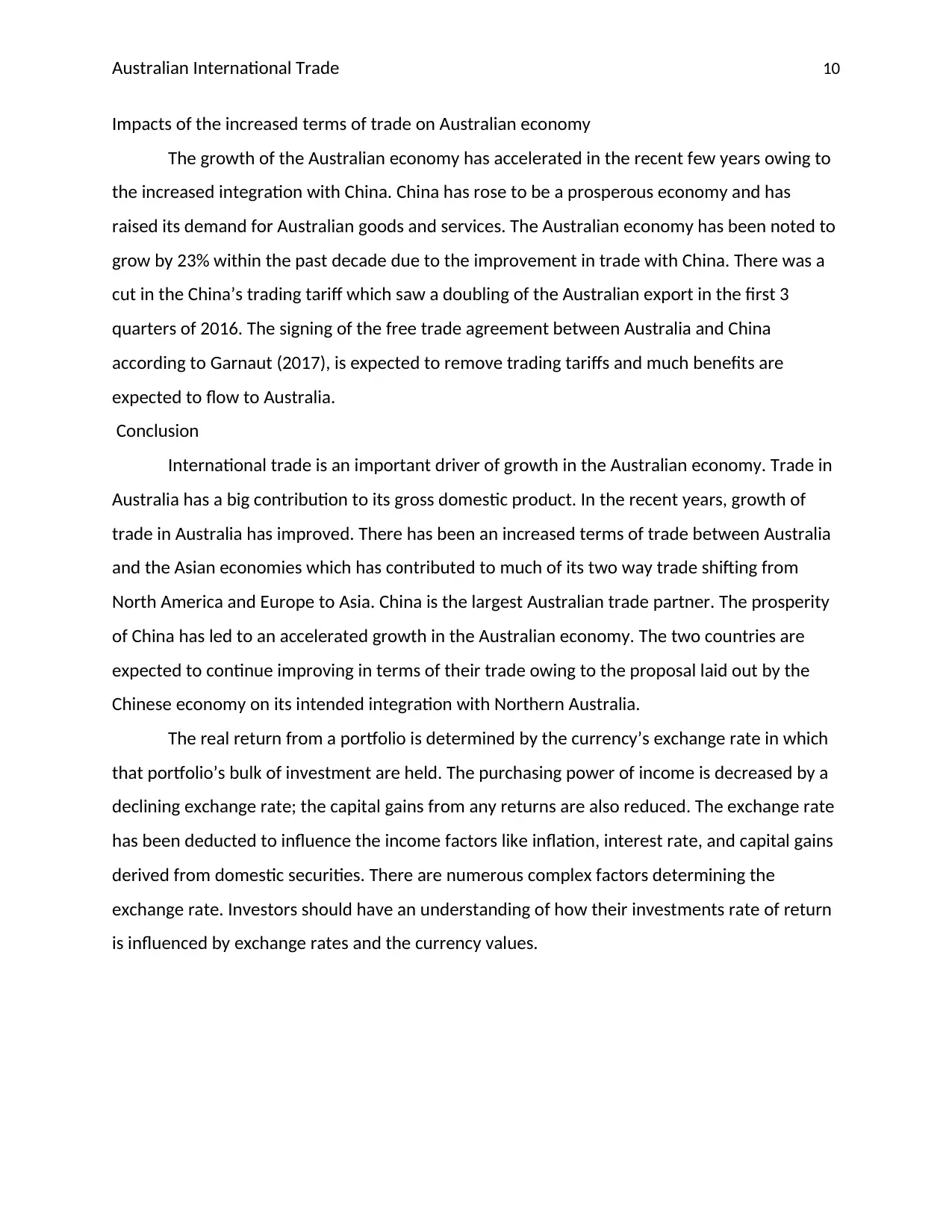
Australian International Trade 10
Impacts of the increased terms of trade on Australian economy
The growth of the Australian economy has accelerated in the recent few years owing to
the increased integration with China. China has rose to be a prosperous economy and has
raised its demand for Australian goods and services. The Australian economy has been noted to
grow by 23% within the past decade due to the improvement in trade with China. There was a
cut in the China’s trading tariff which saw a doubling of the Australian export in the first 3
quarters of 2016. The signing of the free trade agreement between Australia and China
according to Garnaut (2017), is expected to remove trading tariffs and much benefits are
expected to flow to Australia.
Conclusion
International trade is an important driver of growth in the Australian economy. Trade in
Australia has a big contribution to its gross domestic product. In the recent years, growth of
trade in Australia has improved. There has been an increased terms of trade between Australia
and the Asian economies which has contributed to much of its two way trade shifting from
North America and Europe to Asia. China is the largest Australian trade partner. The prosperity
of China has led to an accelerated growth in the Australian economy. The two countries are
expected to continue improving in terms of their trade owing to the proposal laid out by the
Chinese economy on its intended integration with Northern Australia.
The real return from a portfolio is determined by the currency’s exchange rate in which
that portfolio’s bulk of investment are held. The purchasing power of income is decreased by a
declining exchange rate; the capital gains from any returns are also reduced. The exchange rate
has been deducted to influence the income factors like inflation, interest rate, and capital gains
derived from domestic securities. There are numerous complex factors determining the
exchange rate. Investors should have an understanding of how their investments rate of return
is influenced by exchange rates and the currency values.
Impacts of the increased terms of trade on Australian economy
The growth of the Australian economy has accelerated in the recent few years owing to
the increased integration with China. China has rose to be a prosperous economy and has
raised its demand for Australian goods and services. The Australian economy has been noted to
grow by 23% within the past decade due to the improvement in trade with China. There was a
cut in the China’s trading tariff which saw a doubling of the Australian export in the first 3
quarters of 2016. The signing of the free trade agreement between Australia and China
according to Garnaut (2017), is expected to remove trading tariffs and much benefits are
expected to flow to Australia.
Conclusion
International trade is an important driver of growth in the Australian economy. Trade in
Australia has a big contribution to its gross domestic product. In the recent years, growth of
trade in Australia has improved. There has been an increased terms of trade between Australia
and the Asian economies which has contributed to much of its two way trade shifting from
North America and Europe to Asia. China is the largest Australian trade partner. The prosperity
of China has led to an accelerated growth in the Australian economy. The two countries are
expected to continue improving in terms of their trade owing to the proposal laid out by the
Chinese economy on its intended integration with Northern Australia.
The real return from a portfolio is determined by the currency’s exchange rate in which
that portfolio’s bulk of investment are held. The purchasing power of income is decreased by a
declining exchange rate; the capital gains from any returns are also reduced. The exchange rate
has been deducted to influence the income factors like inflation, interest rate, and capital gains
derived from domestic securities. There are numerous complex factors determining the
exchange rate. Investors should have an understanding of how their investments rate of return
is influenced by exchange rates and the currency values.
Paraphrase This Document
Need a fresh take? Get an instant paraphrase of this document with our AI Paraphraser
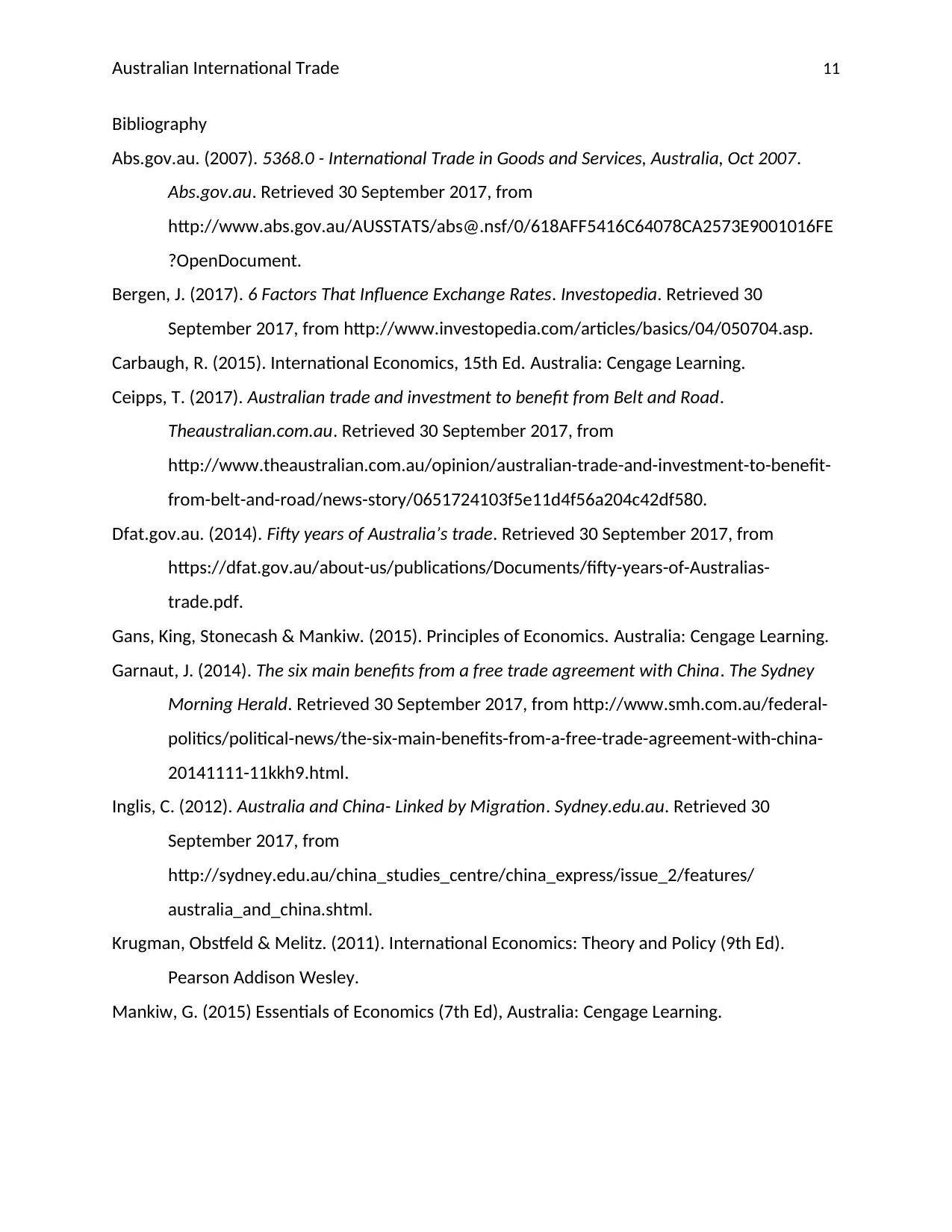
Australian International Trade 11
Bibliography
Abs.gov.au. (2007). 5368.0 - International Trade in Goods and Services, Australia, Oct 2007.
Abs.gov.au. Retrieved 30 September 2017, from
http://www.abs.gov.au/AUSSTATS/abs@.nsf/0/618AFF5416C64078CA2573E9001016FE
?OpenDocument.
Bergen, J. (2017). 6 Factors That Influence Exchange Rates. Investopedia. Retrieved 30
September 2017, from http://www.investopedia.com/articles/basics/04/050704.asp.
Carbaugh, R. (2015). International Economics, 15th Ed. Australia: Cengage Learning.
Ceipps, T. (2017). Australian trade and investment to benefit from Belt and Road.
Theaustralian.com.au. Retrieved 30 September 2017, from
http://www.theaustralian.com.au/opinion/australian-trade-and-investment-to-benefit-
from-belt-and-road/news-story/0651724103f5e11d4f56a204c42df580.
Dfat.gov.au. (2014). Fifty years of Australia’s trade. Retrieved 30 September 2017, from
https://dfat.gov.au/about-us/publications/Documents/fifty-years-of-Australias-
trade.pdf.
Gans, King, Stonecash & Mankiw. (2015). Principles of Economics. Australia: Cengage Learning.
Garnaut, J. (2014). The six main benefits from a free trade agreement with China. The Sydney
Morning Herald. Retrieved 30 September 2017, from http://www.smh.com.au/federal-
politics/political-news/the-six-main-benefits-from-a-free-trade-agreement-with-china-
20141111-11kkh9.html.
Inglis, C. (2012). Australia and China- Linked by Migration. Sydney.edu.au. Retrieved 30
September 2017, from
http://sydney.edu.au/china_studies_centre/china_express/issue_2/features/
australia_and_china.shtml.
Krugman, Obstfeld & Melitz. (2011). International Economics: Theory and Policy (9th Ed).
Pearson Addison Wesley.
Mankiw, G. (2015) Essentials of Economics (7th Ed), Australia: Cengage Learning.
Bibliography
Abs.gov.au. (2007). 5368.0 - International Trade in Goods and Services, Australia, Oct 2007.
Abs.gov.au. Retrieved 30 September 2017, from
http://www.abs.gov.au/AUSSTATS/abs@.nsf/0/618AFF5416C64078CA2573E9001016FE
?OpenDocument.
Bergen, J. (2017). 6 Factors That Influence Exchange Rates. Investopedia. Retrieved 30
September 2017, from http://www.investopedia.com/articles/basics/04/050704.asp.
Carbaugh, R. (2015). International Economics, 15th Ed. Australia: Cengage Learning.
Ceipps, T. (2017). Australian trade and investment to benefit from Belt and Road.
Theaustralian.com.au. Retrieved 30 September 2017, from
http://www.theaustralian.com.au/opinion/australian-trade-and-investment-to-benefit-
from-belt-and-road/news-story/0651724103f5e11d4f56a204c42df580.
Dfat.gov.au. (2014). Fifty years of Australia’s trade. Retrieved 30 September 2017, from
https://dfat.gov.au/about-us/publications/Documents/fifty-years-of-Australias-
trade.pdf.
Gans, King, Stonecash & Mankiw. (2015). Principles of Economics. Australia: Cengage Learning.
Garnaut, J. (2014). The six main benefits from a free trade agreement with China. The Sydney
Morning Herald. Retrieved 30 September 2017, from http://www.smh.com.au/federal-
politics/political-news/the-six-main-benefits-from-a-free-trade-agreement-with-china-
20141111-11kkh9.html.
Inglis, C. (2012). Australia and China- Linked by Migration. Sydney.edu.au. Retrieved 30
September 2017, from
http://sydney.edu.au/china_studies_centre/china_express/issue_2/features/
australia_and_china.shtml.
Krugman, Obstfeld & Melitz. (2011). International Economics: Theory and Policy (9th Ed).
Pearson Addison Wesley.
Mankiw, G. (2015) Essentials of Economics (7th Ed), Australia: Cengage Learning.
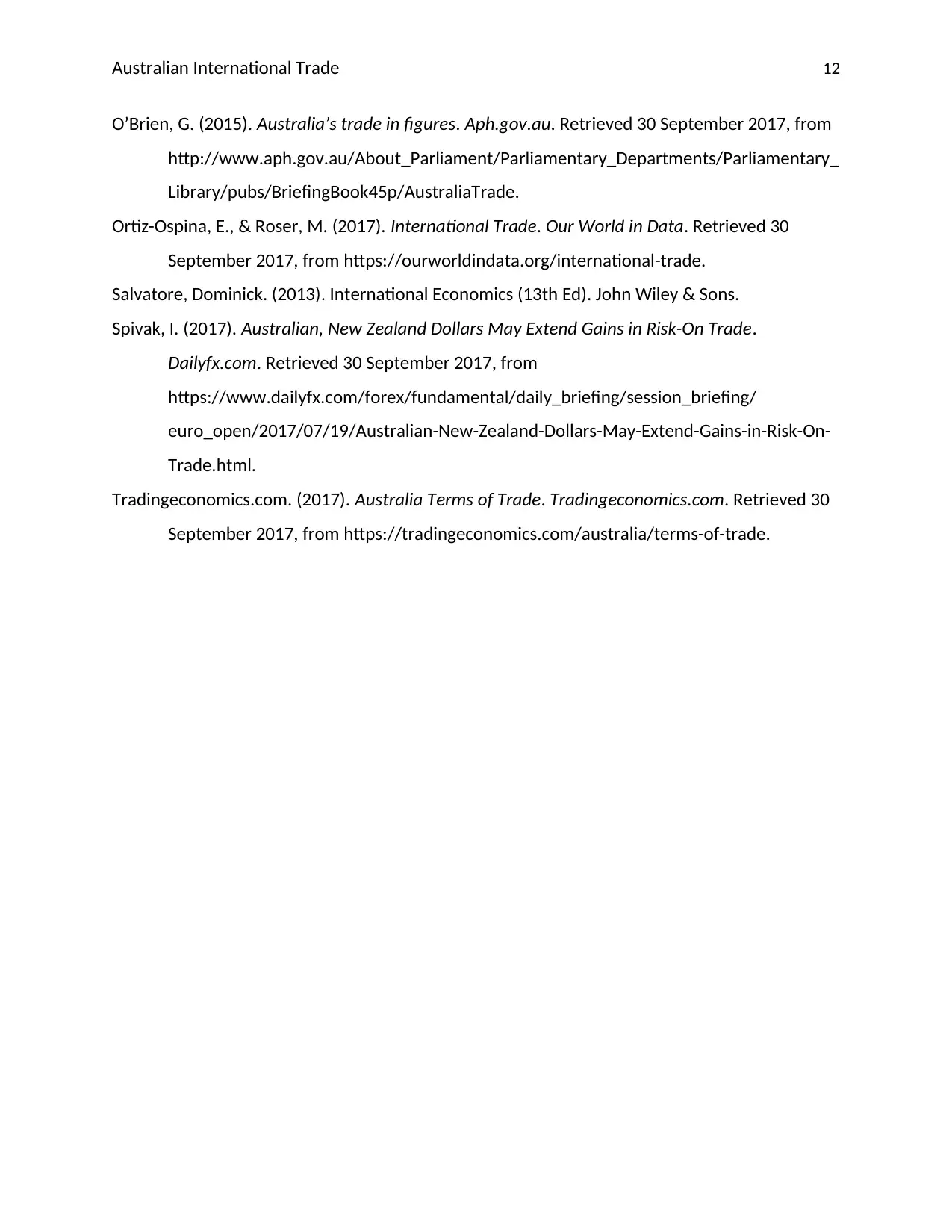
Australian International Trade 12
O’Brien, G. (2015). Australia’s trade in figures. Aph.gov.au. Retrieved 30 September 2017, from
http://www.aph.gov.au/About_Parliament/Parliamentary_Departments/Parliamentary_
Library/pubs/BriefingBook45p/AustraliaTrade.
Ortiz-Ospina, E., & Roser, M. (2017). International Trade. Our World in Data. Retrieved 30
September 2017, from https://ourworldindata.org/international-trade.
Salvatore, Dominick. (2013). International Economics (13th Ed). John Wiley & Sons.
Spivak, I. (2017). Australian, New Zealand Dollars May Extend Gains in Risk-On Trade.
Dailyfx.com. Retrieved 30 September 2017, from
https://www.dailyfx.com/forex/fundamental/daily_briefing/session_briefing/
euro_open/2017/07/19/Australian-New-Zealand-Dollars-May-Extend-Gains-in-Risk-On-
Trade.html.
Tradingeconomics.com. (2017). Australia Terms of Trade. Tradingeconomics.com. Retrieved 30
September 2017, from https://tradingeconomics.com/australia/terms-of-trade.
O’Brien, G. (2015). Australia’s trade in figures. Aph.gov.au. Retrieved 30 September 2017, from
http://www.aph.gov.au/About_Parliament/Parliamentary_Departments/Parliamentary_
Library/pubs/BriefingBook45p/AustraliaTrade.
Ortiz-Ospina, E., & Roser, M. (2017). International Trade. Our World in Data. Retrieved 30
September 2017, from https://ourworldindata.org/international-trade.
Salvatore, Dominick. (2013). International Economics (13th Ed). John Wiley & Sons.
Spivak, I. (2017). Australian, New Zealand Dollars May Extend Gains in Risk-On Trade.
Dailyfx.com. Retrieved 30 September 2017, from
https://www.dailyfx.com/forex/fundamental/daily_briefing/session_briefing/
euro_open/2017/07/19/Australian-New-Zealand-Dollars-May-Extend-Gains-in-Risk-On-
Trade.html.
Tradingeconomics.com. (2017). Australia Terms of Trade. Tradingeconomics.com. Retrieved 30
September 2017, from https://tradingeconomics.com/australia/terms-of-trade.
⊘ This is a preview!⊘
Do you want full access?
Subscribe today to unlock all pages.

Trusted by 1+ million students worldwide
1 out of 12
Related Documents
Your All-in-One AI-Powered Toolkit for Academic Success.
+13062052269
info@desklib.com
Available 24*7 on WhatsApp / Email
![[object Object]](/_next/static/media/star-bottom.7253800d.svg)
Unlock your academic potential
Copyright © 2020–2025 A2Z Services. All Rights Reserved. Developed and managed by ZUCOL.





